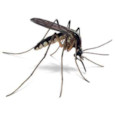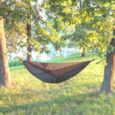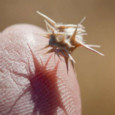While camping in Kansas is usually pleasant, safe, and easy, there are certain challenging aspects you need to be aware of, some of them unique to the state:
Weather
Although Kansas has a temperate climate, with four true and distinct seasons, it still has its share of extreme weather, which can make camping difficult or even dangerous at times.
Special Considerations: Insects
 Dealing with insects while camping can be a major annoyance, and sometimes a health risk. Kansas is not unique in this regard, and much better than many places in the world, but insects can still "bug" you to no end here.
Dealing with insects while camping can be a major annoyance, and sometimes a health risk. Kansas is not unique in this regard, and much better than many places in the world, but insects can still "bug" you to no end here.
These are the most common pests to deal with:
- Chiggers – Walk through grass or woodlands at certain times of the year, and you'll likely find itchy red welts on your body in the most out-of-the-way (and embarrassing) places. These are caused by an extremely tiny insect that attaches itself to your skin and causes a reaction. Protect yourself with insect repellent, and by washing yourself thoroughly after exposure.
- Mosquitoes – These are usually worst right at dusk, in low-lying areas near water. Protect yourself with bug netting, insect repellent, and by staying in open areas with a breeze, away from open or stagnant water.
- Spiders – Most spiders in Kansas are harmless. They may bite if provoked, but will not seek you out. Dangerous spiders are relatively rare, but examples in Kansas include the Brown Recluse, Black Widow, and Yellow Sack. If you suspect you'be been bitten by a venomous spider, seek medical attention at once.
- Ticks – These little bloodsuckers attach themselves to your skin, and can spread disease and illness among both humans and animals. They are most commonly found in grass, weeds, and woodlands, less often in open areas. After walking (or cycling) through a suspect area, inspect yourself for ticks. It's best if you catch them before they become attached. Learn more from the CDC.
Insects are most active during the summer months, and are usually not an issue in the colder months of the year.
Special Considerations: Snakes
 The vast majority of snakes in Kansas are harmless (and should not be harmed). That is not to say that they won't bite, if threatened, but they are not venomous.
The vast majority of snakes in Kansas are harmless (and should not be harmed). That is not to say that they won't bite, if threatened, but they are not venomous.
Dangerous snakes in Kansas include the Copperhead, the Prairie Rattlesnake, the Timber Rattlesnake, the Western Cottonmouth, the Western Diamondback Rattlesnake, and the Western Massasauga Rattlesnake.
The best thing to do if you encounter a snake is to simply leave it alone. Most snakes will avoid humans. If you think you may have been bitten by a venomous snake, seek immediate medical attention.
Special Considerations: Hammocks
 Many people who camp seem to prefer to use hammocks rather than tents, and certainly, they have their advantages: you don't need flat ground, no sticks or rocks poking you in the back at night, fewer concerns about insects or wildlife, and hammocks are typically much lighter than tents.
Many people who camp seem to prefer to use hammocks rather than tents, and certainly, they have their advantages: you don't need flat ground, no sticks or rocks poking you in the back at night, fewer concerns about insects or wildlife, and hammocks are typically much lighter than tents.
However, hammocks usually have a requirement that many places in Kansas just can't be found: two trees, not too big, not too small, spaced just the right distance apart, with nothing between.
In the western part of the state, with a scarcity of trees, those conditions are rare in the wild. And even in towns, it can be a challenge to find an acceptable site (and locals can be quite protective of any perceived damage or risk to their trees).
In the eastern part of the state, there are plenty of trees, but there is often a lot of undergrowth – grass, weeds, bushes, younger trees. Again, it can be quite difficult to find a site that works.
So if you can't count on finding a good hammock site, then you're obliged to either pitch your hammock on the ground, like a tent (which usually doesn't work all that well), or carry a separate tent (which negates any weight savings).
So hammocks can certainly be used in Kansas, but they may present some challenges...
Special Considerations: Goatheads
 The Puncturevine (AKA "Goathead") is a ground plant common in most of Kansas, but particularly virulent in the western 3/4 of the state, that produces spiny, thorny seeds that can be a bicyclist's worst enemy.
The Puncturevine (AKA "Goathead") is a ground plant common in most of Kansas, but particularly virulent in the western 3/4 of the state, that produces spiny, thorny seeds that can be a bicyclist's worst enemy.
The plant spreads rapidly, forming a dense mat that can overtake open ground, roadsides, and even lawns. Goatheads are the cause of numerous flat bicycle tires. Riding (or pushing) a bike through a batch of puncturevine can result in tires covered in the nasty thorns. You'll have no choice but to stop and pick them off one by one, and hope that none of the spikes break off and work their way through the tire casing to puncture the tube.
Goatheads can also be hazardous to air mattresses. I've had them work their way through both a ground sheet and tent floor, to puncture my mattress. A flat air mattress is not of much use, can be difficult to repair, and expensive to replace.
Goatheads are best avoided. Be alert about wheeling through grassy or weedy areas, and watch out where you set up your campsite.


